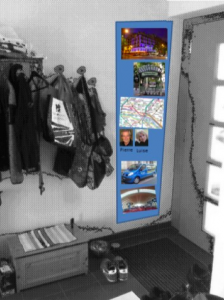In this post we want to discuss the application of a concept known as Déjà vu; making use of its effects we envision technologies that make new situations and encounters more familiar and less threatening.
Going to new places, interacting with new people and carrying out new tasks is part of everyday life. New situations create a sense of excitement but in many cases also anxiety based on a fear of the unknown.
In RECALL we started exploring the use of peripheral displays to automatically provide information about potential future experiences in order to allow people to learn incidentally and without conscious effort about new environments and people. The expectation is that having visual information provided, we can create a sense of déjà vu when people are in a new situation. We use the term déjà vu it a positive sense, following the definition of the Oxford dictionary: “feeling of having already experienced the present situation”.
The basic idea of a déjà vu system is to utilize peripheral displays in the home and work environment to present small information chunks that (potentially) have future relevance for a person. In order to achieve this, the following functions are required:
- Anticipation of future information need.
- Gathering of relevant information.
- Selecting and chunking of information.
- Scheduling presentation of information on displays.
We started investigating and addressing the three technological challenges such a system summons:
- Building a personal future information-need sensor.
- Creating information provision components that gather information about anticipated future events.
- Déjà vu display system presentation software that runs on peripheral displays placed in home and work environments.
The following scenario of starting a new job aims to illustrate the concept:
A person has been offered the chance to change departments at work and will soon be heading to a new group in production. Once she has accepted the offer information about the new working environment is included on her déjà vu board (see Fig.1, 2). Photos of future co-workers and their names, pictures of the parking lot, the building, the offices, meeting rooms, and the production area are included. It also shows a map of the relevant parts of the building and the surrounding areas that a lot of employees use for their lunch breaks. The déjà vu board also presents information about the new product the person will be working on, from images where the product is sold in stores to sequences from the manufacturing process. On the first day of her new job she will already know some of her colleague’s names and faces and the environment will not be unfamiliar.

Presenting information that may be useful in the future is relatively non-critical, as the user would not have actively searched for this information otherwise. However, if the system worked well this may change and people could start to rely on peripheral information and on picking up relevant information incidentally. This, in turn, may reduce their willingness for actively collecting information prior to an event. Providing the information and media in a pleasant and aesthetic way that can be easily learned and remembered without additional effort is essential. The display should not create information overload and should be designed that is can be easily ignored by people.
We started investigating the benefits and uses of such a system in everyday situations. How will users benefit from such a system in their everyday routines? How can one use this approach to remember more short-term items, such as important events in a week or even a day? In such situations, predictions will be harder as special events might be harder to detect, and periods for displaying useful information will be much shorter.

Therefore are working on creating déjà vu display prototypes and deploy these in home and office environments. Hereby we are especially interested in how such technology impacts the users experience in new situations, focusing on the scenarios relating to international travel and to objects acquired by the user. Designing and performing such experiments will also require a careful selection of stimuli and corresponding parameters to record.
[1] A. Schmidt, N. Davies, M. Langheinrich, G. Ward (2014). Déjà Vu – Technologies That Make New Situations Look Familiar: Position Paper. In Proceedings of the 2014 ACM International Joint Conference on Pervasive and Ubiquitous Computing: Adjunct Publication, ACM, New York, NY, USA, 2014, pp. 1389–1396. doi:10.1145/2638728.2641720.